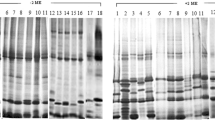Abstract
Electrophoretic analysis of 26 enzyme coding genes was conducted on accessions of threeCitrullus species and the relatedPraecitrullus fistulosus andAcanthosicyos naudinianus. The isozyme phylogeny of the genusCitrullus and the related species was constructed based on pairwise measurements of the respective genetic distances between the species and races.P. fistulosus andA. naudinianus form two distinct outgroups toCitrullus which is characterized by two main clusters: The first includes twoC. colocynthis races and the second,C. lanatus andC. lanatus var.citroides, which are more closely related to each other than they are toC. ecirrhosus. The isozyme phylogeny is consistent with the variability in six seed protein bands and with the crossability relations among the examined species.
Similar content being viewed by others
References
Galili, G., Feldman, M., 1983: Genetic control of endosperm protein in wheat. I. The use of high resolution one-dimensional gel electrophoresis for the allocation of genes coding for endosperm protein subunits in the common wheat cultivar Chinese Spring. — Theor. Appl. Genet.64, 97–101.
Gottlieb, L. D., 1981: Gene number in species ofAstreae that have different chromosome numbers. — Proc. Nat. Acad. Sci. U.S.A.78, 3726–3729.
Hartigan, J., 1979: Cluster analysis of variables. — InDixon, W. J., Brown, M. D., (Eds.): Biomedical Computer Programs (BMDP series). — University of California.
Jeffrey, C., 1975: Further notes onCucurbitaceae: III. Some Southern African taxa. — Kew Bull.30, 475–493.
Ladizinsky, G., 1985: Founder effect in crop-plant evolution. — Econ. Bot.39, 191–199.
Meeuse, A. D., 1962: TheCucurbitaceae of Southern Africa. — Bothalia8, 1–111.
Nei, M., 1972: Genetic distance between populations. — Amer. Naturalist106, 283–292.
Pangalo, K. I., 1944: A new genus of the familyCucurbitaceae—Praecitrullus, an ancestor of the contemporary watermelon (Citrullus Forsk.). — J. Bot. de l'U.S.S.R.,29, 200–204.
Perl-Treves, R., Zamir, D., Navot, N., Galun, E., 1985: Phylogeny ofCucumis based on isozyme variability and its comparison with the plastome phylogeny. — Theor. Appl. Genet.71, 430–436.
Vallejos, C. E., 1983: Enzyme activity staining. — InTansksley, S. D., Orton, T. J., (Eds.): Isozymes in Plant Genetics and Breeding. — Amsterdam: Elsevier, North Holland Press.
Whitaker, T. W., Davis, G. N., 1962: Cucurbits. — New York: Leonard Hill Books.
Zamir, D., Ladizinsky, G., 1984: Genetics of allozyme variants in lentil. — Euphytica33, 329–336.
, 1984: Enzyme polymorphism inCitrullus lanatus andC. colocynthis in Israel and Sinai. — Pl. Syst. Evol.146, 163–170.
Zohary, D., 1983: Wild genetic resources of crops in Israel. — Israel J. Bot.32, 97–127.
Author information
Authors and Affiliations
Rights and permissions
About this article
Cite this article
Navot, N., Zamir, D. Isozyme and seed protein phylogeny of the genusCitrullus (Cucurbitaceae). Pl Syst Evol 156, 61–67 (1987). https://doi.org/10.1007/BF00937202
Received:
Issue Date:
DOI: https://doi.org/10.1007/BF00937202




